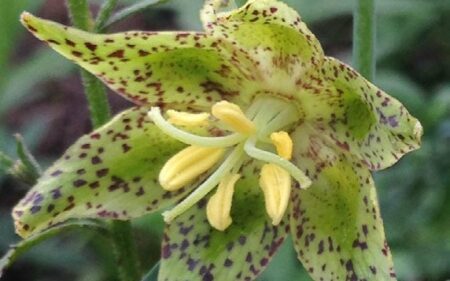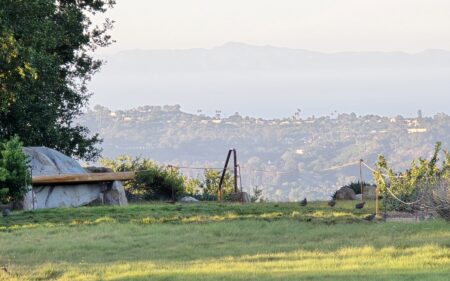Guardians of the Woodland: Monitoring Emerald Ash Borer Before It Strikes California
The emerald ash borer (EAB) is a species of jewel beetle native to Northeast Asia that spread to North America in 2002 and has become a widespread concern for California and the Pacific Northwest, as these non-native beetles have an insatiable appetite for ash trees (Fraxinus), as their common name suggests. EAB have the potential to cause major death and destruction to California’s five native species of ash and other trees in the ash family (Oleaceae).
Almost one year ago, Santa Barbara Botanic Garden started the Forest Entomology and Pathology Program in conjunction with CalFire, an initiative for the early detection and monitoring of emerald ash borer (EAB) using baited funnel traps. This program was introduced in last year’s article, Emerald Ash Borer | Detecting Early, Responding Rapidly by Keith Nevison, director of horticulture and operations at the Garden.
While EAB has not been detected in California, there is a significant chance they will make their way south from Oregon, where their presence was first detected in 2022. If found, rapid pest management strategies would ensue, most effectively with early detection. The Garden’s preventative work with CalFire, in monitoring for EAB, is essential for maintaining the biodiversity of California’s woodland ecosystems.
As an update to this ongoing project, we’ve interviewed Kim Corella, the forest pathologist at CalFire, who runs the Forest Entomology and Pathology Program in Southern California. With a love for the outdoors and an extensive background in forest pathology, Kim’s expertise is incredibly valuable for the study and prevention of EAB establishment. In the following Q&A, you can find her insight on the emerald ash borer and the program’s continuing fight to detect the presence and prevent the spread of EAB, how to identify EAB infestations, and what you can do to help.
Kim, tell me a bit about you and your role with Cal Fire.
I am from upstate New York and became interested in forestry when I went to college at SUNY College of Environmental Science and Forestry. During my senior year, I switched my major from Natural Resources to a double major in Natural Resources/Environmental Forest Biology. This added an extra year to my undergrad, but after I took the forest pathology course being offered, that’s when I fell in love with forest pathology and knew that I wanted to pursue it as a career.
I continued my education at Texas A&M University, receiving my Master of Science in plant pathology. I worked for the Texas Forest Service for six years as Oak Wilt Coordinator, then took a grant-funded position at the University of Nevada, Reno conducting research on de-icing road salts and conifer dieback in Lake Tahoe. Following this, I joined Cal Poly San Luis Obispo as Forest Pest Specialist for Southern California and then eventually Cal Fire as Forest Pest Specialist for Southern California.
When I’m not deep into my research, I love spending time with my family outside – hiking, fishing, exploring, camping, etc. I also love animals and adore my horse, three dogs, and two cats.
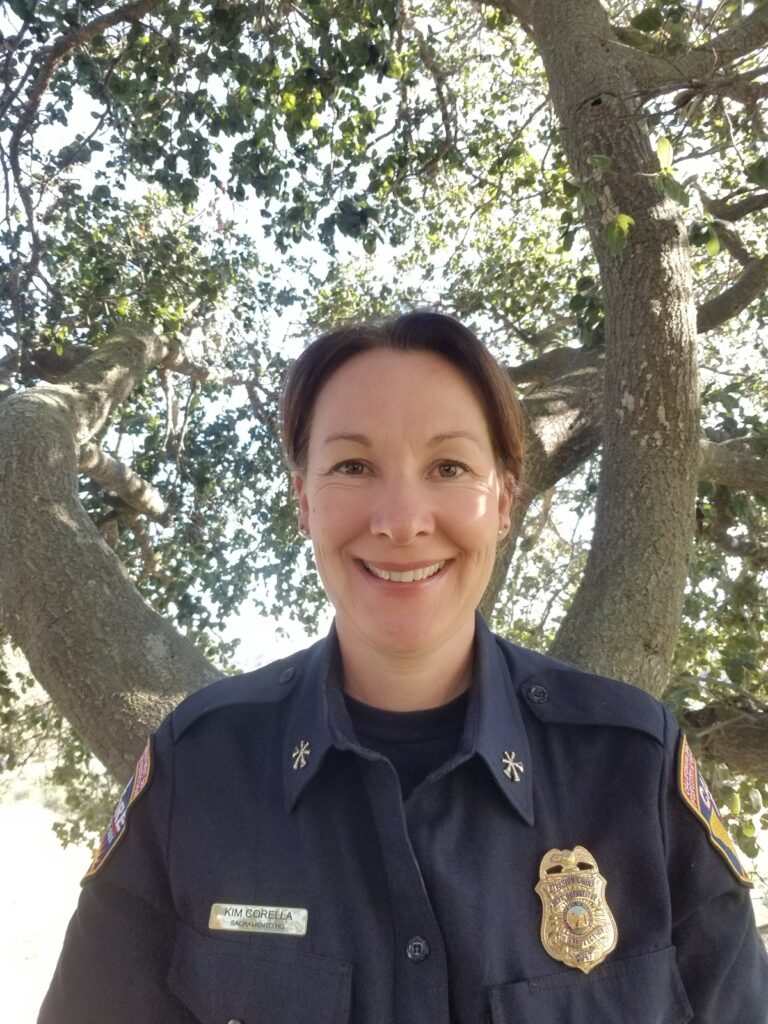
As a Forester II with Cal Fire, what does your position cover?
In my role at Cal Fire, I’m responsible for the Forest Entomology and Pathology Program for Southern California. Currently, my area covers Monterey to San Diego County. You’ll find me responding to and managing insect and disease matters on state and private lands. Some of the duties I have are providing technical assistance, biological evaluations on forest health issues, conducting applied research, planning, and conducting pest surveys and trainings.
I work a lot with invasive insects and diseases such as the goldspotted oak borer, invasive shot hole borer, pitch canker, and sudden oak death, but I also work with native insects and diseases as well. I don’t really have a typical day. Each day is different and can vary from general office work to fieldwork (surveying, training, research, and site visits). I have a great position and work with amazing colleagues. I’m extremely lucky to work in a field I absolutely love.
What are some signs you may have EAB and are they only attracted to Ash?
Emerald Ash Borer only attacks the genus Fraxinus or ash trees. This insect is named emerald ash borer because it is emerald in color, attacks only ash trees and is a wood borer. To date, all North American ash species encountered by Emerald Ash Borer are susceptible, though there are degrees of susceptibility.
The main symptoms and signs that an ash tree has EAB would be:
Exterior Symptoms:



Woodpecker flaking off the outer bark
Interior Symptoms:


Tell me more about the life cycle of an EAB.
The entire life cycle takes place in the cambium (inner layer) and phloem (bark) of the tree.
The leaf canopy of the tree will begin to look thin because as EAB chews through the tree’s water and nutrient-conducting tissues (leaving the serpentine gallery pattern), it effectively strangles the tree. If there are high populations of EAB in the tree, the leafy canopy in ash trees will start to die in a few years. A third to a half of the branches may die in one year. Most of the canopy will be dead within two years of when symptoms are first seen.
Sometimes ash trees push out sprouts from the trunk after the upper portions of the tree die. As the beetles begin to become adults, the pupae are just beneath the bark and woodpeckers are known to flake off the bark to eat the EAB pupae. When the adult beetles emerge during the summer, they chew a “D”-shaped hole in the bark, roughly one-eighth of an inch in diameter.
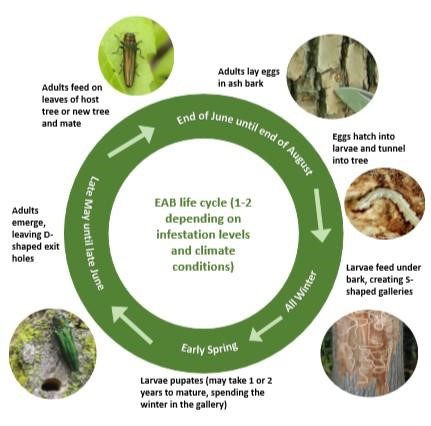
What specific methods are being used to detect the presence of EAB – within our community and at the Garden?
Early detection and monitoring are critically important for managing invasive species because once population levels expand and build to high densities, management becomes increasingly difficult. To aid in this, we survey and use traps to effectively monitor.
EAB are attracted to specifically green and purple colors, so the traps we use for EAB are either purple or green. The best type of traps for EAB are purple sticky traps or green funnel traps, seen below. Trap placement also influences EAB captures. EAB are more active in the afternoon in sunny locations and prefer to attack trees grown in full sun rather than in shade. Traps placed in the south or sun-exposed aspect of the tree capture more EAB.
At the Garden, I have placed one green funnel trap in the canopy of ashes in the Arroyo.
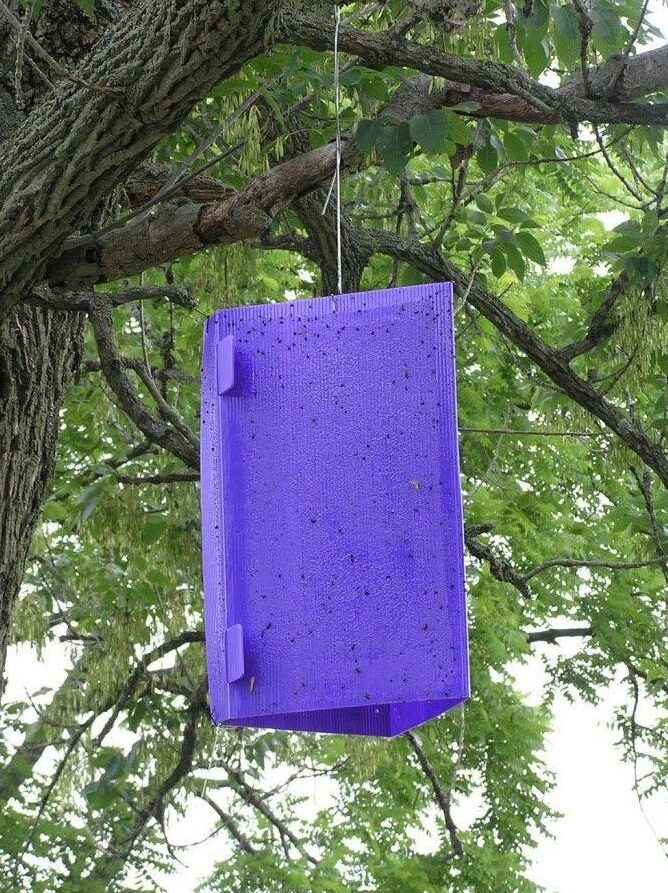
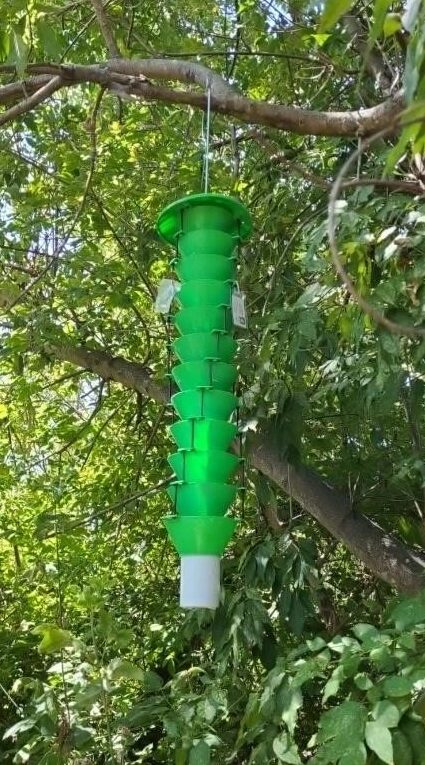
How effective are funnel traps and the attractant cis-3-Hexenol in capturing EAB and are these toxic to other insects/wildlife?
The green funnel traps with the cis-3-Hexenol lure are 75-80% effective in trapping female EAB at very low population levels. The attractant cis-3-Hexanol is a natural volatile produced from ash leaves and there are no known impacts to other insects and wildlife.
Why is EAB considered a minor pest in its native range but highly destructive in North America?
In its native range, EAB is only a minor pest, and infestations are consistently associated with stressed and dying trees. This is because the Asian ash trees have coevolved with emerald ash borer and thus have high resistance and targeted defenses for EAB. Because of the inherent resistance to EAB, Asian ash species may be a source of resistance genes that could be used for breeding efforts for EAB-resistant ash.
What are the potential ecological impacts if EAB spreads to California’s native ash trees?
Most EAB-induced ash mortality within an invaded stand occurs over just a few years, resulting in widespread gap formation with potentially cascading direct and indirect effects on forest community composition and ecosystem processes. These effects include an altered understory environment, nutrient cycles, facilitation of the spread of light-limited invasive plants, and increased coarse woody debris.
At least 282 arthropod species feed on ash, including at least 43 species with ash as their sole food source that may be at risk of extinction, as ash is eliminated from the ecosystem.
How can the public help in preventing the spread of EAB?
- Looking at the condition of your trees – knowing how your trees look and if they look stressed (thin crown, off-color, some dying branches) is important. If ash trees look stressed, investigating a little bit more and looking for small “D” shaped exit holes could identify an EAB infestation very early on.
- Learn how to identify ash trees, https://csfs.colostate.edu/forest-management/ash-tree-identification/
- Look at ash trees when walking around your house or neighborhood and report anything suspicious.
- EAB lives in the bark of an infested ash tree for one to two years. DON’T MOVE FIREWOOD. This is how many new areas have become infested. Many invasive species move on firewood unknown to the individuals moving it.
i. We currently have very important invasive insects and diseases in California that can spread very easily by firewood, so it’s very important not to move firewood. In Southern California, we have an invasive insect very similar to EAB called the goldspotted oak borer or GSOB that attacks and kills oak trees. EAB and GSOB have the same lifecycle, and GSOB has killed over 200,000 large mature oak trees in Southern California. The current spread is most likely the result of infested firewood movement.
- Reporting any suspected or suspicious finds to local County Agriculture Commissioner or County Extension Offices or CDFA report a pest hotline at 1-800-491-1899.
Has EAB been detected in CA and what measures are in place to respond quickly if EAB is detected in California?
EAB has been detected at the CDFA border stations on suspected ash firewood. The suspected EAB-infested ash firewood was managed properly to eliminate the threat of EAB into California.
We are currently trapping and surveying in high-risk areas for EAB (ports of entry, campgrounds, ash tree populations, state parks, RV locations, firewood storage and distribution lots, etc.). If EAB is found, there will be a rapid response plan that includes integrated pest management strategies, outreach, and education, monitoring, and surveys for EAB, removal and proper management of infested trees, and management of uninfected trees.
How often are the funnel traps checked by CAL FIRE staff?
The funnel traps are checked once a month by Cal Fire staff to ensure captured insects are identified before they decay.
What other tree species in California might be at risk from EAB infestation?
Ash trees are the main host known to be attacked by EAB, however alternative hosts that have the potential to be attacked are White fringetree (Chionanthus virginicus, C. henryae) and cultivated olive (Olea Europaea). However, these alternate hosts have not been found to be infested in the field.
How has EAB spread so rapidly across North America since its initial detection in 2002 and what fuels the spread (livestock, vegetation, etc)?
Regional spread of EAB is from both long-distance movement and transport of infested ash trees, logs, or firewood, and short distance spread from flight of an EAB adult. Artificial transport of EAB – sometimes across considerable distances – and the difficulty of identifying trees with low to moderate densities of EAB larvae (which typically exhibit few external signs or symptoms of infestation) result in new EAB infestations that are easily missed. Also, EAB larvae can complete development and emerge from logs or firewood a year (or sometimes longer) after trees are felled, so wood or logs that were thought to be uninfested were actually infested.
What are the long-term plans for monitoring and managing EAB in SB and at the Garden?
First, EAB is not currently in CA, and we hope to keep it that way.
The long-term plans are to keep monitoring in California, including Santa Barbara and at the Garden as long as we have funding, cooperative support, and the ability to do so. EAB is now in Oregon and is much closer to California than ever before. The first step of an EAB early detection and rapid response plan is to conduct outreach and education and continue monitoring and surveying. We are committed to protecting California ash and the broader ecosystem from the invasive emerald ash borer.
Are there any other studies beyond EAB we should mention?
The invasive goldspotted oak borer has been recently found in Ventura County for the first time. The movement is most likely from the spread of moving-infested oak firewood. GSOB is not in Santa Barbara County but has the high potential to move based on previous spread of GSOB in California. This insect prefers and kills large mature coast live oaks and California black oaks. More information on this insect can be found at www.gsob.org.
 Donate
Donate